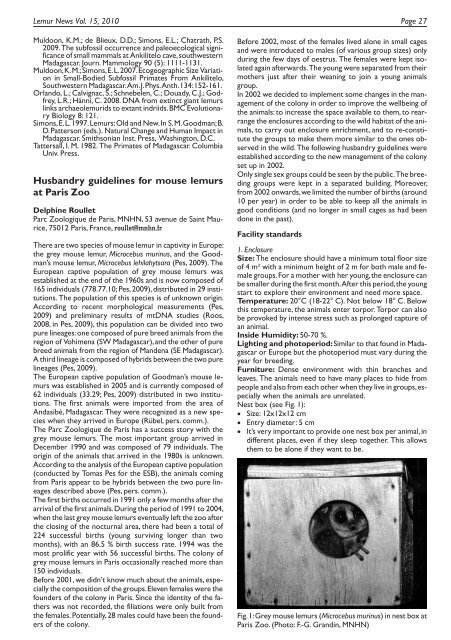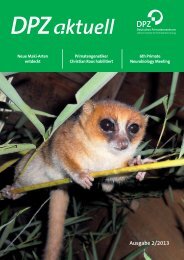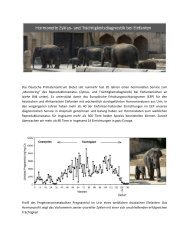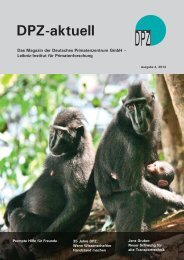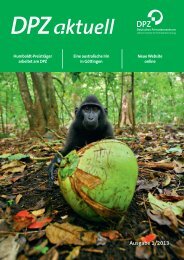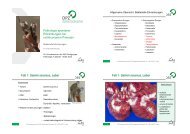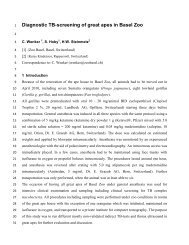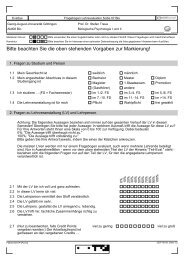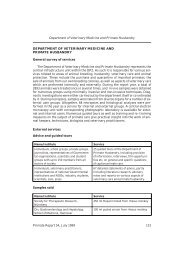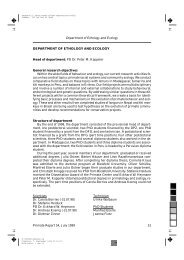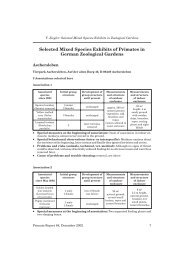Vol. 15 - Deutsches Primatenzentrum
Vol. 15 - Deutsches Primatenzentrum
Vol. 15 - Deutsches Primatenzentrum
Create successful ePaper yourself
Turn your PDF publications into a flip-book with our unique Google optimized e-Paper software.
Lemur News <strong>Vol</strong>. <strong>15</strong>, 2010 Page 27<br />
Muldoon, K.M.; de Blieux, D.D.; Simons, E.L.; Chatrath, P.S.<br />
2009.The subfossil occurrence and paleoecological significance<br />
of small mammals at Ankilitelo cave,southwestern<br />
Madagascar. Journ. Mammology 90 (5): 1111-1131.<br />
Muldoon,K.M.;Simons,E.L.2007.Ecogeographic Size Variation<br />
in Small-Bodied Subfossil Primates From Ankilitelo,<br />
Southwestern Madagascar.Am.J.Phys.Anth.134:<strong>15</strong>2-161.<br />
Orlando, L.; Calvignac, S.; Schnebelen, C.; Douady, C.J.; Godfrey,<br />
L.R.; Hänni, C. 2008. DNA from extinct giant lemurs<br />
links archaeolemurids to extant indriids.BMC Evolutionary<br />
Biology 8: 121.<br />
Simons,E.L.1997.Lemurs:Old and New.In S.M.Goodman;B.<br />
D.Patterson (eds.). Natural Change and Human Impact in<br />
Madagascar. Smithsonian Inst. Press, Washington, D.C.<br />
Tattersall, I. M. 1982. The Primates of Madagascar. Columbia<br />
Univ. Press.<br />
Husbandry guidelines for mouse lemurs<br />
at Paris Zoo<br />
Delphine Roullet<br />
Parc Zoologique de Paris, MNHN, 53 avenue de Saint Maurice,<br />
75012 Paris, France, roullet@mnhn.fr<br />
There are two species of mouse lemur in captivity in Europe:<br />
the grey mouse lemur, Microcebus murinus, and the Goodman’s<br />
mouse lemur, Microcebus lehilahytsara (Pes, 2009). The<br />
European captive population of grey mouse lemurs was<br />
established at the end of the 1960s and is now composed of<br />
165 individuals (778.77.10; Pes, 2009),distributed in 29 institutions.<br />
The population of this species is of unknown origin.<br />
According to recent morphological measurements (Pes,<br />
2009) and preliminary results of mtDNA studies (Roos,<br />
2008, in Pes, 2009), this population can be divided into two<br />
pure lineages:one composed of pure breed animals from the<br />
region of Vohimena (SW Madagascar),and the other of pure<br />
breed animals from the region of Mandena (SE Madagascar).<br />
A third lineage is composed of hybrids between the two pure<br />
lineages (Pes, 2009).<br />
The European captive population of Goodman’s mouse lemurs<br />
was established in 2005 and is currently composed of<br />
62 individuals (33.29; Pes, 2009) distributed in two institutions.<br />
The first animals were imported from the area of<br />
Andasibé, Madagascar. They were recognized as a new species<br />
when they arrived in Europe (Rübel, pers. comm.).<br />
The Parc Zoologique de Paris has a success story with the<br />
grey mouse lemurs. The most important group arrived in<br />
December 1990 and was composed of 79 individuals. The<br />
origin of the animals that arrived in the 1980s is unknown.<br />
According to the analysis of the European captive population<br />
(conducted by Tomas Pes for the ESB), the animals coming<br />
from Paris appear to be hybrids between the two pure lineages<br />
described above (Pes, pers. comm.).<br />
The first births occurred in 1991 only a few months after the<br />
arrival of the first animals.During the period of 1991 to 2004,<br />
when the last grey mouse lemurs eventually left the zoo after<br />
the closing of the nocturnal area, there had been a total of<br />
224 successful births (young surviving longer than two<br />
months), with an 86.5 % birth success rate. 1994 was the<br />
most prolific year with 56 successful births. The colony of<br />
grey mouse lemurs in Paris occasionally reached more than<br />
<strong>15</strong>0 individuals.<br />
Before 2001, we didn’t know much about the animals, especially<br />
the composition of the groups.Eleven females were the<br />
founders of the colony in Paris. Since the identity of the fathers<br />
was not recorded, the filiations were only built from<br />
the females. Potentially,28 males could have been the founders<br />
of the colony.<br />
Before 2002, most of the females lived alone in small cages<br />
and were introduced to males (of various group sizes) only<br />
during the few days of oestrus. The females were kept isolated<br />
again afterwards.The young were separated from their<br />
mothers just after their weaning to join a young animals<br />
group.<br />
In 2002 we decided to implement some changes in the management<br />
of the colony in order to improve the wellbeing of<br />
the animals: to increase the space available to them, to rearrange<br />
the enclosures according to the wild habitat of the animals,<br />
to carry out enclosure enrichment, and to re-constitute<br />
the groups to make them more similar to the ones observed<br />
in the wild. The following husbandry guidelines were<br />
established according to the new management of the colony<br />
set up in 2002.<br />
Only single sex groups could be seen by the public.The breeding<br />
groups were kept in a separated building. Moreover,<br />
from 2002 onwards,we limited the number of births (around<br />
10 per year) in order to be able to keep all the animals in<br />
good conditions (and no longer in small cages as had been<br />
done in the past).<br />
Facility standards<br />
1. Enclosure<br />
Size: The enclosure should have a minimum total floor size<br />
of 4 m² with a minimum height of 2 m for both male and female<br />
groups.For a mother with her young,the enclosure can<br />
be smaller during the first month.After this period,the young<br />
start to explore their environment and need more space.<br />
Temperature: 20°C (18-22° C). Not below 18° C. Below<br />
this temperature, the animals enter torpor. Torpor can also<br />
be provoked by intense stress such as prolonged capture of<br />
an animal.<br />
Inside Humidity: 50-70 %.<br />
Lighting and photoperiod:Similar to that found in Madagascar<br />
or Europe but the photoperiod must vary during the<br />
year for breeding.<br />
Furniture: Dense environment with thin branches and<br />
leaves. The animals need to have many places to hide from<br />
people and also from each other when they live in groups,especially<br />
when the animals are unrelated.<br />
Nest box (see Fig. 1):<br />
Size: 12x12x12 cm<br />
Entry diameter: 5 cm<br />
It’s very important to provide one nest box per animal,in<br />
different places, even if they sleep together. This allows<br />
them to be alone if they want to be.<br />
Fig.1:Grey mouse lemurs (Microcebus murinus) in nest box at<br />
Paris Zoo. (Photo: F.-G. Grandin, MNHN)


